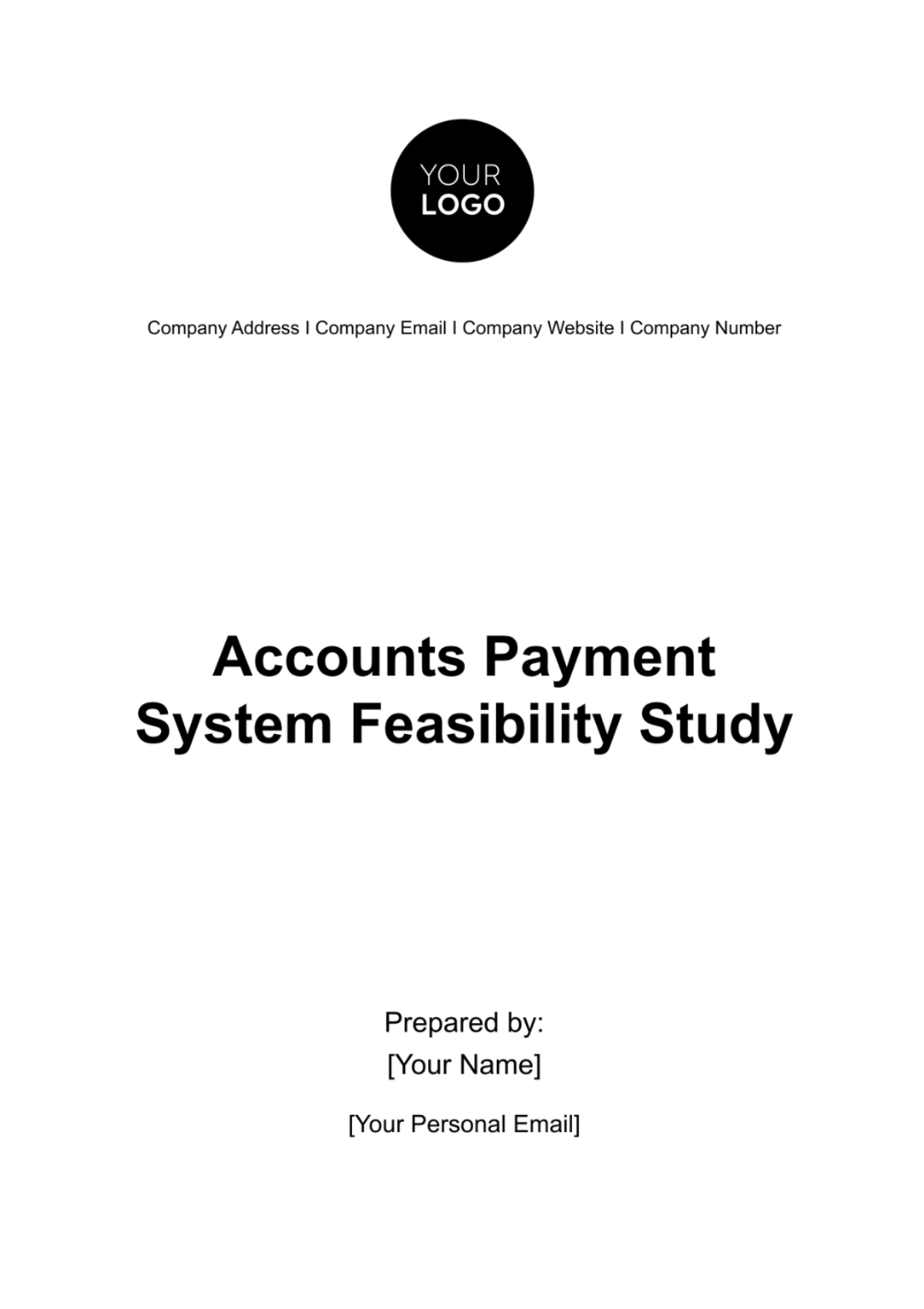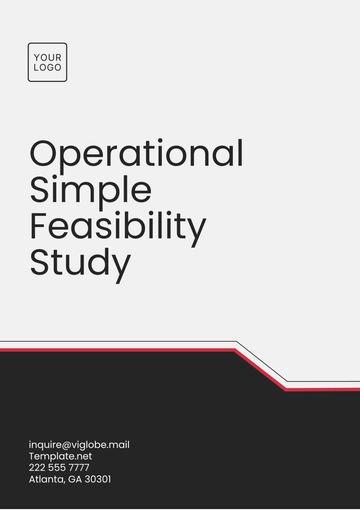Free Accounts Payment System Feasibility Study

Executive Summary
In this Feasibility Study, we examine the viability of implementing a new Accounts Payment System, aiming to enhance our financial operations' efficiency, accuracy, and compliance. This study encapsulates a thorough analysis, encompassing market trends, technical requirements, operational impacts, financial implications, legal and compliance considerations, risk assessment, and an implementation plan.
Market Analysis: We have observed a significant shift towards automated and integrated payment solutions in our industry. Our analysis indicates that adopting a more advanced system could position us competitively, improving both client satisfaction and operational efficiency.
Technical Feasibility: The proposed system requires an initial investment in new software and hardware integration. It is estimated that the new software, along with necessary hardware upgrades, will cost approximately $250,000. We have assessed our current IT infrastructure and identified areas that need enhancement to support this system.
Operational Feasibility: The implementation of this system is expected to streamline our payment processes, reduce manual errors, and enhance data security. Training for our staff is estimated at $20,000, ensuring smooth transition and minimal operational disruption.
Financial Feasibility: Our financial analysis forecasts a return on investment (ROI) within three years post-implementation. The projected savings from improved efficiency and error reduction are estimated at $75,000 annually, with a 15% increase in payment processing speed. The total estimated cost for system implementation, including training and infrastructure upgrades, is $350,000.
Legal and Compliance Considerations: The new system will adhere to all relevant financial and data protection regulations. This compliance ensures we avoid potential legal penalties and strengthens our reputation for reliability and security in handling transactions.
Risk Assessment: We have identified key risks associated with system implementation, including integration challenges and potential downtime. Mitigation strategies include phased implementation and comprehensive staff training.
Implementation Plan: A phased approach over six months is proposed for the implementation, ensuring minimal disruption to our ongoing operations.
Conclusion and Recommendations: Based on our analysis, the proposed Accounts Payment System is a financially viable and operationally beneficial investment. It is projected to enhance our efficiency, ensure compliance, and offer a competitive edge in our market sector. We recommend proceeding with the implementation, adhering to the outlined plan and budget.
Introduction
Our current accounts payment system, operational for over a decade, primarily relies on semi-automated processes with significant manual intervention. It includes a basic software application for managing accounts payable and receivable, coupled with manual data entry and verification processes. Payment processing is moderately paced, prone to human errors, and lacks advanced analytics capabilities. Additionally, the system operates in isolation, lacking integration with other financial modules and databases within our organization.
The Need for a New or Upgraded System
In the face of evolving market dynamics and technological advancements, our existing system has become increasingly inadequate. The primary challenges we face include:
Inefficiency and Error-proneness: Manual interventions lead to slower processing times and higher error rates.
Lack of Integration: The system's inability to integrate with other financial modules results in disjointed financial management.
Inadequate Reporting and Analytics: Current reporting tools are limited, hindering strategic decision-making.
Compliance Risks: Emerging financial regulations demand more robust data handling and reporting capabilities, which our current system cannot support.
Objectives and Scope of the Feasibility Study
The objective of this Feasibility Study is to evaluate the practicality and benefits of implementing a new or upgraded accounts payment system. The study aims to:
Assess Market Needs and Trends: Understanding the latest trends in payment processing and how they align with our organizational needs.
Evaluate Technical Requirements: Identifying the technological advancements necessary for the new system and assessing our current IT infrastructure's compatibility.
Analyze Operational Impact: Determining how the new system will affect our existing operational processes and workflow.
Conduct Financial Analysis: Estimating the cost of implementation, potential financial benefits, and return on investment.
Ensure Legal and Regulatory Compliance: Reviewing all relevant legal requirements and ensuring that the new system complies with these.
Identify and Mitigate Risks: Recognizing potential risks associated with the system upgrade and proposing strategies to mitigate them.
Develop an Implementation Plan: Outlining a detailed plan for the successful deployment of the new system.
Market Analysis
In this section, we delve into the dynamic landscape of accounts payment systems, evaluating how evolving market trends, competitive practices, and industry standards impact our organization's strategic direction. Our analysis is structured to provide a comprehensive understanding of the external environment influencing our decision to upgrade our payment system.
Analysis of Market Trends in Accounts Payment Systems
The current market for accounts payment systems is rapidly evolving, driven by technological advancements and changing business needs. Key trends include:
Automation and AI Integration: There's a significant shift towards fully automated systems that leverage artificial intelligence for enhanced accuracy and efficiency in payment processing.
Cloud-based Solutions: The adoption of cloud-based platforms offers scalability, remote accessibility, and cost-effective solutions.
Mobile Payment Capabilities: The increasing demand for mobile payment solutions reflects a need for more flexible and accessible payment methods.
Enhanced Security Features: As cybersecurity threats evolve, there is a growing emphasis on advanced security protocols to protect sensitive financial data.
Compliance and Reporting Tools: Systems are increasingly incorporating sophisticated tools for regulatory compliance and detailed financial reporting.
These trends indicate a market moving towards more integrated, efficient, and secure payment solutions, emphasizing the need for our organization to adapt accordingly.
Review of Competitive Systems and Practices
To understand our position in the market, we have analyzed the systems and practices employed by our key competitors:
Competitor | System Features | Automation Level | Security Measures | Integration Capabilities |
Competitor A | AI-driven analytics, cloud-based | High | Advanced encryption, multi-factor authentication | Strong, with various financial modules |
Competitor B | Mobile payment options, user-friendly interface | Moderate | Standard encryption, regular security updates | Moderate, limited third-party integrations |
Competitor C | Real-time transaction processing, customizable reports | High | High-level data protection, continuous monitoring | Extensive, including CRM and ERP systems |
This comparison reveals a trend towards highly automated, secure, and integrated systems, highlighting areas where our current system lags behind.
Evaluation of Industry Standards and Compliance Requirements
Our analysis of industry standards and compliance requirements underscores their critical role in the choice of an accounts payment system:
Standard | Description | Our Compliance Status |
GDPR | Protects data privacy for individuals within the EU | Partial compliance, requires enhancement |
PCI DSS | Security standards for all entities handling credit card information | Partially compliant, needs updates |
SOX Compliance | Mandates accurate financial reporting for public companies | Compliant, but requires more robust reporting tools |
These standards dictate stringent requirements for financial data handling and reporting. Our current system's partial compliance with these regulations necessitates an urgent upgrade to ensure full compliance and avoid potential legal repercussions.
Technical Feasibility
In this section, we evaluate the technical feasibility of upgrading our accounts payment system. We focus on understanding the technological requirements of the new system, assessing our existing IT infrastructure, and ensuring compatibility with current systems.
Assessment of the Technological Requirements for the New System
The new accounts payment system necessitates specific technological advancements to meet market demands and improve operational efficiency. Key requirements include:
High-Speed Processing Capabilities: To manage increasing transaction volumes and reduce processing time.
Advanced Security Features: Including data encryption and fraud detection mechanisms.
Scalable Infrastructure: To accommodate future growth and changes in transaction volume.
User-Friendly Interface: Ensuring ease of use for employees and clients.
Comprehensive Reporting Tools: For better financial management and compliance.
Requirement | Description | Importance |
High-Speed Processing | Accelerated transaction handling | Critical |
Advanced Security | Enhanced data protection measures | Essential |
Scalability | Ability to grow with the organization | High |
User Interface | Intuitive and accessible design | Moderate |
Reporting Tools | Detailed and customizable reports | High |
Evaluation of Existing IT Infrastructure and Needed Upgrades
Our current IT infrastructure requires significant upgrades to support the new system. The evaluation highlights:
Server Capacity: Current servers are insufficient for the proposed system's data processing needs.
Network Stability: Enhanced network stability and speed are necessary to handle increased data flow.
Data Storage: Expanded storage solutions are needed for growing transactional data.
Existing Infrastructure | Current Status | Required Upgrades |
Servers | Limited capacity | Upgrade to high-capacity servers |
Network | Moderate stability | Enhance network stability and speed |
Data Storage | Basic storage capabilities | Expand storage solutions |
Software and Hardware Requirements
Implementing the new system demands specific software and hardware:
Software: Advanced payment processing software with AI capabilities, secure encryption, and comprehensive reporting features.
Hardware: High-performance servers, robust network equipment, and secure data storage systems.
Requirement | Description | Importance |
Software | Advanced payment processing and security features | Critical |
Hardware | High-capacity servers and network equipment | Essential |
Compatibility with Existing Systems
Ensuring compatibility with our existing systems is crucial to prevent disruptions:
Data Migration: Seamless data migration from the old to the new system.
Integration: Compatibility with existing financial and CRM software.
Compatibility Aspect | Requirement | Importance |
Data Migration | Smooth transition of existing data | Critical |
Integration | Seamless integration with current software | High |
Operational Feasibility
This section assesses the operational feasibility of integrating a new accounts payment system into our existing procedures. We evaluate how this system will align with current operations, its impact on staff and workflow, the necessary training for users, and the required changes in business processes.
Analysis of How System Will Fit into Current Procedures
Introducing the new accounts payment system will necessitate a reevaluation of our current operational procedures. The system is designed to automate many processes that are currently manual, thereby increasing efficiency and reducing the likelihood of errors. Key considerations include ensuring the system's alignment with our transaction processing cycle, accounts management, and financial reporting. The automation of these processes will enable more timely and accurate financial operations, though it may initially disrupt familiar workflows.
Impact on Staff and Workflow
The adoption of the new system will significantly impact our staff and their workflow. Roles and responsibilities may shift to focus more on system management and analysis, rather than manual data entry and processing. This change could lead to a temporary decrease in productivity as staff adapt to the new system. However, in the long term, it is expected to lead to greater efficiency, reduced workload due to automation, and enhanced job satisfaction due to less repetitive tasks.
Training Requirements for Users
Effective training is crucial for the smooth integration of the new system. All users, including finance and accounting staff, will require training on system functionalities, data input procedures, and report generation. We anticipate a comprehensive training program, including online tutorials, in-person workshops, and continuous support during the initial phase of the system rollout. The estimated budget for this training is approximately $20,000, reflecting the need for specialized training modules tailored to our organizational requirements.
Changes in Business Processes
The introduction of the new system will lead to changes in several business processes. These include:
Streamlined Payment Processing: Reduction in manual tasks and faster transaction processing.
Automated Reporting: Shift from manual report generation to automated, real-time financial reporting.
Enhanced Data Management: Improved data accuracy and easier access to financial information.
Compliance Monitoring: Automated compliance checks and reporting.
These changes are expected to enhance overall business efficiency and decision-making capabilities, aligning our processes with contemporary financial management standards.
Financial Feasibility
In this section, we assess the financial feasibility of implementing the new accounts payment system, focusing on the associated costs and the potential financial benefits. We analyze the initial setup costs, ongoing operational costs, maintenance expenses, and explore various funding options, ensuring a comprehensive understanding of the financial implications.
Cost Analysis
The implementation of the new accounts payment system involves various costs, categorized as follows:
Initial Setup Costs: Includes the purchase of software, hardware, and expenses related to system customization and integration.
Operational Costs: Encompasses costs related to system operation, including utility expenses, software updates, and personnel costs.
Maintenance Costs: Ongoing expenses for system maintenance, technical support, and upgrades.
Cost Type | Description | Estimated Amount |
Initial Setup | Software, hardware, integration | $250,000 |
Operational | Utility, updates, staff | $50,000 annually |
Maintenance | System maintenance and support | $25,000 annually |
Potential Financial Benefits and Return on Investment (ROI)
The new system is projected to bring substantial financial benefits:
Increased Efficiency: Reduction in processing time leading to cost savings in operational expenses.
Error Reduction: Decrease in manual errors, thereby reducing financial losses due to inaccuracies.
Improved Cash Flow Management: Better management of receivables and payables, enhancing overall cash flow.
Considering the estimated cost savings and improved efficiency, the expected ROI is calculated to be achieved within three years of system implementation.
Funding Options and Budgetary Considerations
To finance this project, several funding options are considered:
Internal Reserves: Utilizing a portion of our existing reserves.
Bank Loans: Exploring loan options with favorable interest rates.
Investment: Seeking external investors for funding in exchange for a stake in the project.
Each option comes with its implications on our financial health:
Funding Option | Amount | Implications |
Internal Reserves | $150,000 | Reduces dependency on external funding but decreases available cash reserves |
Bank Loan | $200,000 | Introduces debt but allows retention of full project control |
Investment | $100,000 | Reduces initial financial burden but dilutes ownership |
Legal and Compliance Considerations
The implementation of a new accounts payment system necessitates stringent adherence to various legal and regulatory frameworks. These laws and regulations are designed to ensure the integrity, confidentiality, and security of financial transactions and data. Our commitment to compliance not only safeguards our operations but also reinforces our reputation and trustworthiness in the market. It is imperative that the new system aligns with the following key U.S. laws and regulations:
Sarbanes-Oxley Act (SOX): Mandates accurate and reliable corporate disclosures, impacting financial reporting and auditing processes.
Payment Card Industry Data Security Standard (PCI DSS): Sets standards for organizations handling credit card information, emphasizing data security.
Gramm-Leach-Bliley Act (GLBA): Requires financial institutions to explain their information-sharing practices to customers and safeguard sensitive data.
Fair Credit Reporting Act (FCRA): Regulates the collection and use of consumer information, including credit reporting.
Bank Secrecy Act (BSA): Requires financial institutions to assist government agencies in detecting and preventing money laundering.
Risk Assessment
Implementing a new accounts payment system involves various risks that must be identified and mitigated. The following table outlines key risks, their likelihood, potential impact, and our planned mitigation strategies:
Risk | Likelihood | Impact | Mitigation Strategy |
System Integration Issues | Moderate | High | Conduct thorough testing and phased implementation |
Data Migration Challenges | High | Moderate | Implement comprehensive data backup and migration plan |
Cybersecurity Threats | High | High | Incorporate advanced security protocols and regular security audits |
Compliance Risks | Low | Very High | Regularly update system in line with changing legal requirements |
User Resistance to Change | Moderate | Moderate | Provide extensive training and support, communicate benefits clearly |
Overbudget and Delays | Moderate | High | Implement strict project management and budget controls |
Technical Failures | Low | High | Establish robust disaster recovery and business continuity plans |
Implementation Plan
The successful deployment of the new accounts payment system requires a meticulously structured implementation plan. This plan outlines the key tasks, timelines, and responsibilities to ensure a seamless transition with minimal operational disruption. The implementation will be executed in phases over a six-month period, enabling us to manage resources effectively, test components progressively, and address any issues promptly.
Task | Month | Responsibility |
Initial System Design and Planning | Month 1 | IT and Finance Departments |
Hardware and Software Acquisition | Month 1-2 | IT Department |
System Installation and Setup | Month 2-3 | IT Department |
Data Migration and Integration Testing | Month 3-4 | IT Department with Finance Oversight |
Staff Training and System Testing | Month 4-5 | Human Resources and IT Departments |
System Go-Live and Monitoring | Month 6 | IT and Finance Departments |
Post-Implementation Review | Month 7 | IT, Finance, and HR Departments |
Evaluation Criteria
To measure the success of the new accounts payment system, we have established specific evaluation criteria with target metrics. These criteria will help us assess the system's performance, identify areas for improvement, and ensure that the system meets our organizational objectives. The evaluation will be conducted at regular intervals post-implementation.
Criteria | Target Metrics |
System Efficiency | Reduction in payment processing time by 20% |
Error Rate | Decrease in error rate by 30% |
User Satisfaction | 80% positive feedback from system users |
Compliance | 100% adherence to relevant legal and regulatory standards |
Return on Investment (ROI) | Achieve ROI within 3 years |
Data Security | Zero breaches/incidents in the first year |
System Uptime | 99% uptime |
Conclusion
Based on our analysis, the proposed Accounts Payment System is a financially viable and operationally beneficial investment. It is projected to enhance our efficiency, ensure compliance, and offer a competitive edge in our market sector. We recommend proceeding with the implementation, adhering to the outlined plan and budget.
- 100% Customizable, free editor
- Access 1 Million+ Templates, photo’s & graphics
- Download or share as a template
- Click and replace photos, graphics, text, backgrounds
- Resize, crop, AI write & more
- Access advanced editor
Discover the Accounts Payment System Feasibility Study Template at Template.net, a strategic tool for evaluating payment system options. This template is remarkably editable and customizable, making it ideal for in-depth analysis tailored to your specific needs. Modify it conveniently using our AI Editor tool. Perfect for assessing the practicality of various payment systems. Rely on Template.net for thorough financial analysis tools.





























